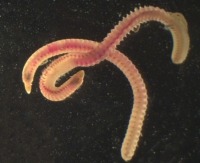
(Photo: Huntsman Marine Science Centre)
Black Footed Ninoe
Ninoe nigripes
The body is elongate, slender, and up to 100 millimetres in length. The head segment is conical and has no eyes. The gills are located along the sides and consist of bundles of one to seven thin branches. The sides of the body segments bear black, needle-like bristles.
Authority
Verrill, 1873
Classification Details
Phylum: Annelida (worms); Class: Polychaeta (bristle worms)
Habitat
Found in the northwest Atlantic from the Gulf of St. Lawrence to Gulf of Mexico, living near the shore and in estuaries. Adults are benthic organisms found in seabed mud, and the larvae are zooplankton. They can live in areas where the mud is mixed with wood pulp. Generally, areas with a high amount of wood pulp are inhospitable, but N. nigripes can survive here.
Diet
Feeds on detritus on the surface of the mud.
Reproduction
Males have white sperm masses, and females have large orange eggs. Females extrude eggs from large pores below their bristles on body segments. The specific details of its reproduction are unknown.
Fun Facts
This worm forms tubes of mucus mixed with mud and sand.
References
Fauchald K and Jumars PA (1979) The diet of worms : a study of polychaete feeding guilds. Oceanography and Marine Biology an Annual Review 17, 193–284. Pettibone MH (1963) Marine Polychaete Worms of the New England Region. Vol 1. Washington: Smithsonian. Read G and Fauchald K (2020). World Polychaeta database. Ninoe nigripes Verrill, 1873. Accessed through: World Register of Marine Species at: http://www.marinespecies.org/aphia.php?p=taxdetails&id=130255 Accessed online 22 January 2020. Van Guelpen L, Pohle G, Vanden Berghe E and Costello MJ (2005) Marine Species Registers for the North Atlantic Ocean. World Wide Web electronic publication. http://www.vliz.be/vmdcdata/narms/ Yale Peabody Museum of Natural History. Ninoe nigripes Verrill, 1873. https://collections.peabody.yale.edu/search/Record/YPM-IZ-072356 Accessed online 22 January 2020.

